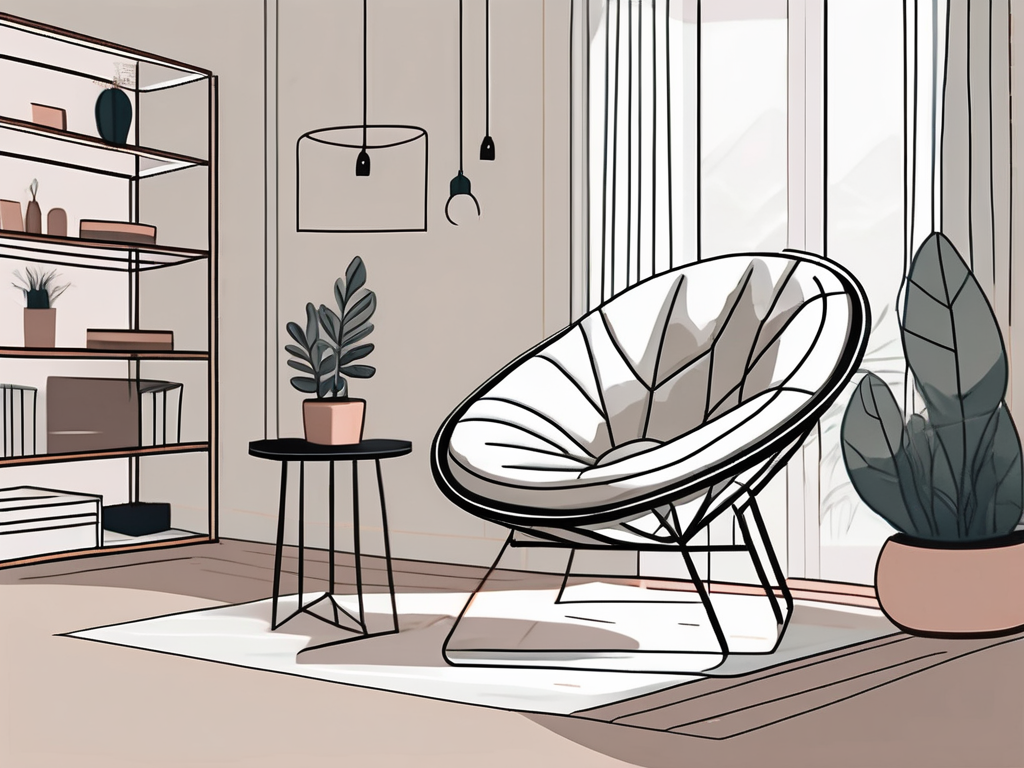Mastering Emphasis in Interior Design: A Comprehensive Guide
Master the art of emphasis in interior design and create eye-catching, well-designed spaces that reflect your personal style.

Emphasis is an important principle in interior design.
Picture a room where your gaze is immediately drawn to a stunning piece of artwork, perfectly framed by the surrounding decor. The colors vibrate against a neutral backdrop, the lighting casts a gentle glow, and the furniture arrangement subtly guides your eye. That's the power of emphasis in interior design. It's not just about creating a focal point; it's about orchestrating a visual symphony where each element plays its part in harmony, creating a space that's both captivating and cohesive.
Understanding Emphasis in Design
Emphasis, in design terms, refers to the creation of a focal point or area of visual interest within a space. It's the element that catches the eye first and around which the rest of the design revolves. Mastering emphasis allows designers to:
- Guide the viewer's eye through a space
- Create a sense of balance and hierarchy
- Highlight key features or prized possessions
- Establish the mood and character of a room
- Control the narrative of the space
- Enhance the functionality of the area
The principle of emphasis is rooted in the way human perception works. Our brains are wired to seek out patterns and points of interest, and by strategically creating these points, designers can influence how people experience and interact with a space.
The Science Behind Visual Emphasis
Understanding the psychological and physiological aspects of visual perception can help in creating more effective emphasis:
- Saccadic Eye Movement: Our eyes make rapid movements (saccades) between fixation points. By strategically placing elements, you can control these movements.
- Foveal vs. Peripheral Vision: We see detail in the center of our vision (foveal) while our peripheral vision detects movement and contrast. Use this to your advantage in placing focal points.
- Pattern Recognition: Our brains naturally seek out patterns. Creating or disrupting patterns can guide attention.
- Color Processing: The human eye processes color before shape or text. This makes color a powerful tool for emphasis.
- Gestalt Principles: Understanding principles like proximity, similarity, and closure can help in creating cohesive designs with clear focal points.
Techniques for Creating Emphasis
1. Contrast
Contrast is perhaps the most powerful tool in creating emphasis. It can be achieved through:
- Color: A vibrant red accent chair in a predominantly neutral room immediately draws attention. The key is to use color strategically - a small pop of a bold hue can be more effective than large areas of bright color.
- Size: An oversized chandelier in a dining room becomes a focal point through its scale. The contrast between the large fixture and the surrounding space creates immediate visual interest.
- Shape: Introducing curved elements in a room full of straight lines creates visual interest. For example, a round mirror in a bathroom with square tiles and rectangular vanity.
- Texture: A rough, textured wall in a space dominated by smooth surfaces becomes a standout feature. This could be achieved through textured wallpaper, a stone accent wall, or even a tactile art piece.
- Pattern: In a room with solid colors, a patterned element like a rug or curtains can become a focal point.
- Light vs. Dark: Using light and shadow strategically can create emphasis. A dark-painted bookshelf against a light wall, for instance, immediately draws the eye.
2. Placement
Strategic placement can create emphasis without changing the elements themselves:
- Central Positioning: Items placed in the center of a wall or room naturally draw the eye. This works particularly well for statement pieces like a large piece of art or a central fireplace.
- The Rule of Thirds: Positioning key elements at the intersection points of a 3x3 grid can create a balanced yet emphasized design. This principle, borrowed from photography, can be applied to furniture arrangement, art placement, and even architectural features.
- Sight Lines: Placing an item at the end of a natural sight line, such as opposite a doorway, creates immediate focus. This could be a sculpture at the end of a hallway or a striking view framed by a window.
- Asymmetrical Balance: While symmetry can be pleasing, asymmetrical arrangements often create more interesting focal points. For example, a fireplace flanked by mismatched but balanced bookcases.
- Triangulation: Arranging elements in a triangle shape naturally guides the eye. This could be achieved with varying heights of furniture or decor items.
3. Repetition with Exception
Repeating elements create a pattern, and breaking that pattern draws attention:
- A row of identical pendant lights with one in a different color or size
- A gallery wall of black and white photos with a single color image
- A series of matching chairs with one unique piece
- Repetitive architectural elements (like columns) with one highlighted differently
- A bookshelf with books arranged by color, with one shelf breaking the pattern
The key is to make the exception noticeable but not jarring - it should stand out while still feeling part of the overall design.
4. Framing
Creating a frame around an object naturally draws the eye:
- Architectural elements like archways or recessed nooks
- Strategic lighting, such as picture lights or spotlights
- Surrounding a piece of art with negative space on a wall
- Using contrasting paint to create a "frame" on the wall
- Arranging furniture to create a visual frame around a focal point
Framing can also be achieved through more subtle means, like using area rugs to define and highlight seating areas.
5. Color
Color is a powerful tool for creating emphasis:
- Accent Walls: A single wall in a bold color can become the room's focal point. The key is to choose a color that complements the overall palette while providing enough contrast to stand out.
- Color Blocking: Using blocks of color to highlight specific areas or pieces of furniture. This technique can be particularly effective in modern or minimalist spaces.
- Gradients: Subtle color gradients can guide the eye to a specific area. This could be achieved through ombre curtains, a gradient painted wall, or even carefully arranged books or decor items.
- Complementary Colors: Using colors opposite each other on the color wheel creates strong contrast and emphasis. For example, a blue sofa with orange throw pillows.
- Monochromatic with a Twist: In a monochromatic room, introducing a single element in a different color immediately creates a focal point.
6. Texture and Material
Texture and material choices can create subtle yet effective emphasis:
- A textured area rug in a room with smooth surfaces
- A marble fireplace surround in a room with primarily wooden elements
- Metallic accents in a space dominated by matte finishes
- A velvet sofa in a room with primarily linen or cotton upholstery
- Glass or lucite furniture pieces in a room with mostly opaque elements
The interplay of different textures and materials can create depth and interest, guiding the eye and creating emphasis through tactile contrast.
7. Lighting
Lighting is a crucial tool in creating emphasis:
- Accent Lighting: Use spotlights or track lighting to highlight artwork or architectural features.
- Statement Fixtures: A dramatic chandelier or unique floor lamp can become a focal point in itself.
- Layered Lighting: Combine ambient, task, and accent lighting to create depth and focus.
- Natural Light: Strategically placed windows or skylights can create natural focal points.
- Backlighting: Illuminating objects from behind can create a dramatic effect.
- Colored Lighting: While to be used sparingly, colored lights can create striking emphasis.
Balancing Emphasis in a Room
While creating emphasis is crucial, balancing it within the overall design is equally important:
- Hierarchy of Emphasis: Establish primary, secondary, and tertiary points of interest to create a visual journey through the space. The primary focal point should be the most dominant, with secondary and tertiary points supporting the overall composition.
- Negative Space: Allow for areas of visual rest to prevent overwhelming the viewer. Negative space, or "white space," is crucial in giving the eye a place to rest and making the points of emphasis more impactful.
- Distributed Focus: In larger spaces, create multiple points of emphasis that work together harmoniously. These should be connected through color, theme, or style to maintain cohesion.
- Scale and Proportion: Ensure that emphasized elements are appropriately sized for the space. An oversized element can overpower a small room, while a too-small focal point might get lost in a large space.
- Functional Emphasis: Align points of visual emphasis with the functional focal points of the room. For example, in a living room, the visual focal point (like a fireplace) should work in harmony with the functional focal point (like the seating arrangement).
- Flow and Movement: Consider how emphasis points guide movement through the space. They should create a natural flow, not impede traffic or functionality.
- Coherence with Overall Style: Ensure that the methods of creating emphasis align with the overall design style of the space. What works in a minimalist setting might not be appropriate for a more traditional design.
Common Pitfalls to Avoid
- Over-Emphasis: Too many competing focal points can create visual chaos. Stick to one primary focal point per room or defined area.
- Inconsistent Style: Ensure emphasized elements align with the overall design aesthetic. A ultra-modern pendant light might look out of place in a rustic, traditional room.
- Ignoring Architecture: Work with, not against, the existing architectural features of a space. If a room has a stunning view, for instance, make that the focal point rather than trying to compete with it.
- Neglecting Lighting: Proper lighting is crucial in highlighting areas of emphasis. Even the most beautiful focal point can fall flat if not properly illuminated.
- Forced Focal Points: Emphasis should feel natural and purposeful, not contrived. Avoid creating focal points that don't serve the room's function or overall aesthetic.
- Overlooking Scale: Ensure that emphasized elements are appropriately sized for the space. An oversized art piece can overwhelm a small room, while a tiny focal point might get lost in a large space.
- Ignoring Context: Consider the room's purpose and the lifestyle of its occupants. A delicate, intricate focal point might not be practical in a high-traffic area or a home with young children.
Emphasis in Different Room Types
Living Rooms
Often centered around a fireplace or large window. In modern homes, a statement coffee table or media unit can serve as the focal point. Consider:
- A striking piece of oversized art above the sofa
- A feature wall with textured wallpaper or a mural
- A statement chandelier or sculptural ceiling fan
- A uniquely designed or vibrantly colored sofa
- A large, eye-catching area rug that defines the seating area
Bedrooms
The bed is typically the natural focal point. Enhance this with a striking headboard, artwork above the bed, or dramatic bedding. Other options include:
- A feature wall behind the bed with bold wallpaper or paint
- A chandelier or pendant light over the bed
- A large, ornate mirror opposite the bed
- A seating area by a window with a distinctive chair or chaise lounge
- A dramatic canopy or four-poster bed
Kitchens
A bold backsplash, statement range hood, or unique island can create emphasis in the heart of the home. Also consider:
- Open shelving with curated dishware displays
- A colorful or uniquely designed refrigerator
- A striking light fixture over the island or dining area
- A chef's grade stove in a bold color
- A dramatic waterfall countertop on the island
Bathrooms
Consider a striking vanity, a freestanding tub, or a dramatic tile pattern to create focus in these functional spaces. Other ideas:
- A statement mirror or medicine cabinet
- A skylight or unique window treatment
- A bold wallpaper in a powder room
- A dramatic shower enclosure with unique tiling
- A chandelier or unusual lighting fixture
Home Offices
Create a productive and inspiring space with these focal points:
- A statement desk, perhaps in a bold color or unique material
- A gallery wall of inspirational art or photographs
- A dramatic bookshelf with color-coded books
- A unique light fixture, like a designer task lamp
- A textured accent wall behind the desk area
The Role of Lighting in Creating Emphasis
Lighting is a powerful tool for creating and enhancing emphasis:
- Accent Lighting: Use spotlights or track lighting to highlight artwork or architectural features. Adjustable fixtures allow for flexibility as the room's design evolves.
- Statement Fixtures: A dramatic chandelier or unique floor lamp can become a focal point in itself. Consider the fixture's design both when lit and unlit.
- Layered Lighting: Combine ambient, task, and accent lighting to create depth and focus. This allows for different emphasis points to be highlighted at different times of day or for different activities.
- Natural Light: Strategically placed windows, skylights, or glass doors can create natural focal points and enhance other design elements.
- Dimmer Switches: These allow for adjustable lighting levels, changing the emphasis in a room as needed.
- Color Temperature: The warmth or coolness of light can dramatically affect the mood and emphasis in a space. Warmer lights tend to create a cozy, intimate atmosphere, while cooler lights can make a space feel more open and airy.
- Shadow Play: Strategic lighting can create interesting shadows that become design elements in themselves.
Emphasis Through Texture and Material
Texture and material choices can create subtle yet effective emphasis:
- A textured area rug in a room with smooth surfaces
- A marble fireplace surround in a room with primarily wooden elements
- Metallic accents in a space dominated by matte finishes
- Mixing rough and smooth textures, like a sleek leather sofa with a nubby wool throw
- Incorporating natural elements like stone or wood in a modern space
- Using reflective surfaces (mirrors, glass, polished metals) to create depth and bounce light
Creating Emphasis in Small Spaces
In compact areas, emphasis becomes even more crucial:
- Use vertical space to draw the eye upward with tall bookshelves or floor-to-ceiling curtains.
- Incorporate multi-functional furniture pieces that serve as both practical solutions and focal points.
- Utilize mirrors strategically to create the illusion of space and reflect points of emphasis.
- Choose one statement piece rather than several smaller accents to avoid clutter.
- Use lighting to create depth and highlight key areas.
- Consider a bold ceiling color or treatment to draw the eye up and create the illusion of height.
- Use scaled-down furniture to maintain proportion while still creating impact.
For more tips on maximizing small spaces, explore our guide on 42 tips to love your small space.
The Psychology of Emphasis
Understanding the psychological impact of emphasis can enhance its effectiveness:
- Color Psychology: Different colors evoke various emotions and can influence the mood of a space. For example, red is energizing and can increase appetite, making it a good choice for dining areas, while blue is calming and can promote focus, suitable for bedrooms or offices.
- Visual Weight: Heavier visual elements tend to draw more attention and can ground a space. This doesn't necessarily mean physically heavy items, but rather elements that appear substantial or solid.
- Directional Emphasis: Use lines and shapes to guide the viewer's gaze in specific directions. Vertical lines can make a space feel taller, while horizontal lines can make it feel wider.
- Emotional Resonance: Choose focal points that evoke the desired emotional response. A family portrait gallery might create a sense of warmth and belonging, while a striking modern sculpture might evoke sophistication and intrigue.
- Cognitive Load: Be mindful of the amount of visual information presented. Too many points of emphasis can be overwhelming, while too few can make a space feel uninteresting.
- Biophilic Design: Incorporating natural elements or views of nature can reduce stress and improve well-being. Consider making a view of the outdoors or an indoor garden a focal point.
Evolving Emphasis Over Time
A well-designed space allows for the evolution of emphasis:
- Seasonal Changes: Rotate accent pieces or color schemes to reflect different seasons. This could involve changing throw pillows, swapping art prints, or updating window treatments.
- Adaptable Design: Create a neutral base that allows for easy updates to focal points. This might mean choosing versatile furniture pieces and a neutral color palette for walls and large items.
- Collectibles Display: Rotate displayed items to keep the space fresh and interesting. This works well for bookshelves, mantelpieces, or dedicated display areas.
- Lighting Adjustments: Change the emphasis in a room by adjusting lighting. This could involve repositioning lamps, changing bulb types, or updating light fixtures.
- Furniture Rearrangement: Periodically rearranging furniture can create new focal points and traffic patterns, refreshing the feel of a space without major changes.
- Art Rotation: If you have a collection of artwork, consider rotating pieces to create new points of emphasis throughout the year.
- Technology Integration: As technology evolves, consider how new devices or smart home features can be integrated as functional focal points without disrupting the overall design.
- Nature's Influence: Use natural elements that change with the seasons, such as fresh flowers or seasonal plants, to create evolving points of interest.
Advanced Techniques for Creating Emphasis
For those looking to take their design skills to the next level, consider these advanced techniques:
- Forced Perspective: Use design elements to create an optical illusion that emphasizes a particular area or makes a space appear larger or smaller.
- Kinetic Design: Incorporate moving elements, such as mobiles or water features, to create dynamic focal points.
- Interactive Focal Points: Design elements that invite interaction, such as a chalkboard wall or a modular sculpture, can create engaging emphasis.
- Olfactory Emphasis: Use scent to draw attention to certain areas, like a herb garden in the kitchen or a scented candle in the entryway.
- Acoustic Design: Use sound-absorbing or reflecting materials to create auditory focal points or zones of quiet emphasis.
- Sustainable Focal Points: Incorporate eco-friendly design elements, like living walls or upcycled art installations, as unique and meaningful points of emphasis.
Case Studies: Emphasis in Action
To illustrate these principles in real-world applications, let's examine a few case studies:
- The Minimalist Loft: In a spacious loft with high ceilings and an open floor plan, emphasis was created through a massive abstract painting on the main wall. The scale of the artwork drew the eye immediately, while its colors informed the rest of the space's palette.
- The Cozy Cottage: In a small cottage living room, the fireplace was emphasized as the focal point. A reclaimed wood mantel added texture, while symmetrically arranged built-in bookshelves framed the fireplace, drawing attention to its central position.
- The Modern Kitchen: In a sleek, modern kitchen, emphasis was placed on a striking backsplash featuring geometric tiles. The pattern and color of the tiles contrasted with the smooth, neutral cabinets, creating a captivating focal point.
- The Serene Bedroom: A canopy bed served as the focal point in this bedroom, with sheer drapes adding height and drama. Soft, ambient lighting emphasized the bed's prominence while creating a relaxing atmosphere.
Final Thoughts
Mastering emphasis in interior design is about more than just creating a pretty space—it's about crafting an experience. It's the art of guiding the eye, evoking emotions, and telling a story through thoughtful design choices. By understanding and applying the principles of emphasis, you can transform any space from ordinary to extraordinary.
Remember, there's no one-size-fits-all approach to emphasis in design. What works in one space may not work in another. The key is to understand the principles, then apply them creatively based on the specific context of each project. Consider the architecture, the function of the space, the client's preferences, and the overall design style when deciding how to create and balance emphasis.
As you apply these techniques, don't be afraid to experiment. Sometimes, the most striking designs come from unexpected combinations or bold choices. Trust your instincts, but also be willing to step back and view the space objectively. Does the emphasis feel natural? Does it enhance the functionality of the space? Does it create the desired emotional response?
Ultimately, mastering emphasis is about creating spaces that not only look beautiful but also feel right. It's about designing rooms that draw people in, invite them to linger, and leave a lasting impression. Whether you're a professional designer or a homeowner looking to refresh your space, understanding and applying the principles of emphasis will elevate your interiors to new heights.
Ready to put these principles into practice? Explore our curated collection of statement pieces and accent decor at Spoken, where you'll find the perfect elements to create emphasis in your space. From bold accent chairs to eye-catching wall art, we have everything you need to master the art of emphasis in your home.

Dane Hurtubise
Co-founder & CEO of Spoken
Dane Hurtubise is the Co-founder & CEO of Spoken. He has led two venture-backed companies and is a two-time Y Combinator alum. Prior to Spoken, Dane sold his previous company, Parklet, to Greenhouse Software where he served as VP of Platform and Partnerships. An avid runner, cyclist, and Pilates enthusiast, Dane holds a BS in Electrical and Computer Engineering from the University of Texas at Austin.
Read more

